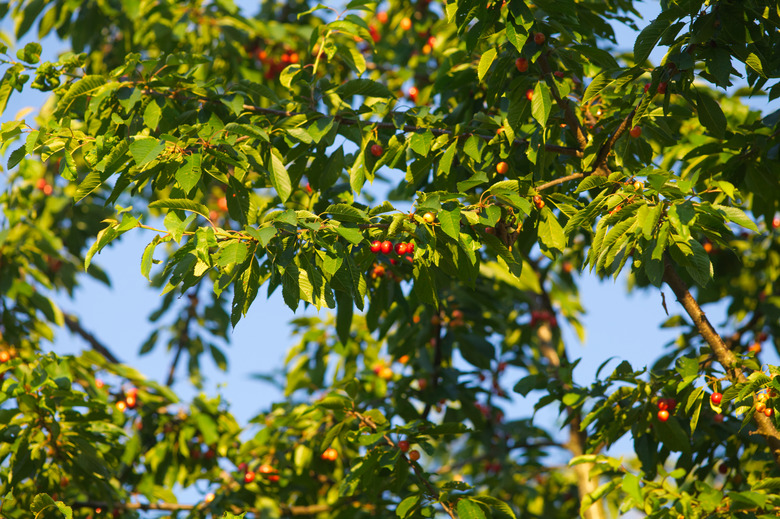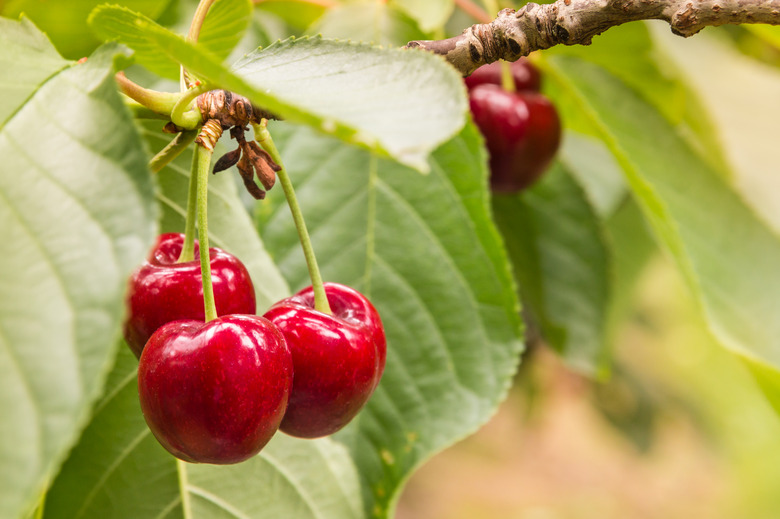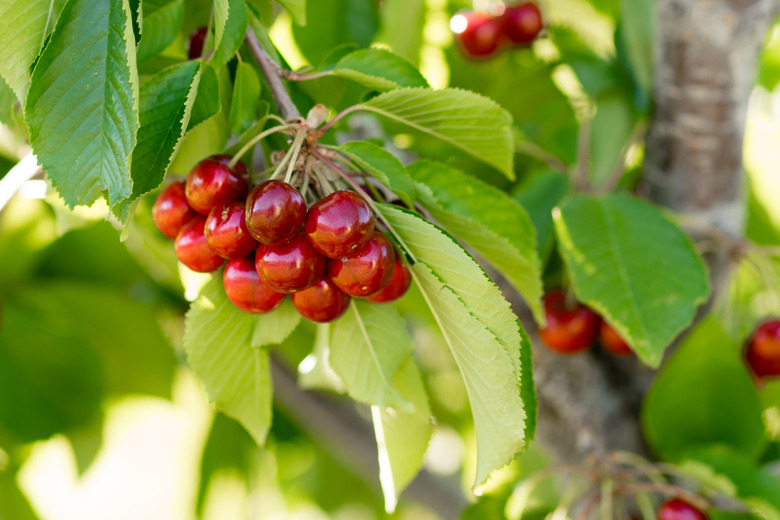How To Grow Cherry Trees
We may receive a commission on purchases made from links.
- Best uses for cherry trees
- How to grow cherry trees
- Starting cherry trees from seed
- Starting cherry trees from a sapling
- In what zone do cherry trees grow best?
- When should you plant cherry trees?
- Soil, sunlight and water recommendations for cherry trees
- How to propagate cherry trees
- How to winterize cherry trees
- How to harvest cherry trees
- Common pests and other problems for cherry trees
- Common diseases for cherry trees
Even to the casual gardener, the first cherry tree blossoms are an unmistakable sign that spring has arrived. To celebrate, cherry blossom festivals are held all over the world. The most famous festival in the United States takes place in Washington, D.C beginning at the end of March when over 3,000 trees gifted to the U.S. by Japan come into bloom.
The trees on the Washington Mall are ornamental cherries that produce inedible fruit. For edible fruit, choose sweet cherry varieties (Prunus avium, USDA zones 3-8 depending on cultivar). Sour cherries (Prunus cerasus, zones 3-8 or 9) are grown for preserves and other cooking purposes.
Sweet cherry cultivars, such as Bing (Prunus avium 'Bing') and Rainier (Prunus avium 'Rainier'), produce white and pink blossoms in the spring and start bearing fruit in midsummer. The trees require regular watering and pruning to shape the tree and stimulate fruit production.
Many varieties of the sweet cherry are self-sterile, meaning they must be planted near another tree of a different cultivar to cross-pollinate, but it can't be just any cherry cultivar because some types are not compatible with others. Check with a nearby garden center or your local cooperative extension service to determine which types work best in your area and determine compatible and incompatible varieties. Some types, such as Stella (Prunus avium 'Stella'), are self-fruitful, or self-pollinating, and are compatible with all varieties.
Best Uses for Cherry Trees
Best Uses for Cherry Trees
Place trees where you can enjoy the spring blooms and where it is easy to reach the fruit. Cherry trees require full sun and good air circulation, so they can't be planted in the shade of another tree or building. When mature, cherry trees can reach up to 20 feet and more, but most varieties are available in semidwarf (10 to 15 feet) and dwarf (6 to 8 feet) types.
Dwarf types can be planted in pots and placed on patios or near entrances. The convenience of planting in pots means you can move the plant when necessary. Those planted in the ground require ample space between trees: 20 feet for standard sizes, 15 feet for semidwarfs and at least 10 feet for dwarf varieties. Cross-pollination depends on birds, bees, insects and even the wind, so it is best to plant compatible trees within 50 feet of one another.
How to Grow Cherry Trees
How to Grow Cherry Trees
- Common Name: Sweet cherry
- Botanical Name: Prunus avium
- When to Plant: Plant in the garden in early spring when temperatures are above 50 degrees Fahrenheit and the soil can be worked easily
- USDA Zones: 3-8, depending on cultivar
- Sun Exposure: Full sun
- Soil Type: Well-balanced, well-draining, fertile soil
- When It's in Trouble: Discolored leaves often due to poor-draining soil
- When It's Thriving: Healthy-looking leaves, upright growth and abundant fruit
Starting Cherry Trees From Seed
Starting Cherry Trees From Seed
Most cherry trees start out as bare-root plants or as potted seedlings, but it is possible to start them from seed. You can buy cherry tree seeds, or you can start them using the pits of the fruit. If you are using cherry pits, get the fruit from a local source, like a farmers' market. If you get the cherries from a grocery store, they may be a variety that will not thrive in your area. It's important to note, however, that many hybrid cherry cultivars will not produce seeds resulting in plants that bear fruits similar to the parent plant, so your best bet is purchasing established plants or seedlings that are identified by cultivar.
Soak the pits overnight in warm water to help remove any traces of fruit that may be clinging to them. Place the pits on paper towels and allow them to dry out for about one week. Then, put the pits in a plastic or glass container with a lid and put the container in the refrigerator for 10 weeks.
Cherry pits require a process called stratification, which is subjecting the pits to a prolonged cold spell where the temperature does not go above 45 degrees Fahrenheit. The stint in the refrigerator accomplishes that. Even when the trees are planted, they need a certain number of chilling hours during the dormant season to produce blossoms and fruit the following year.
After 10 weeks, allow the pits to come up to room temperature. Fill small pots with well-draining potting soil. Plant three pits in each pot and cover with a little soil. Place the containers in a sunny spot and keep the soil moist. When the seedlings are about 2 inches tall, remove the two weakest.
Seedlings are ready for transplanting into the garden when they reach about 8 to 12 inches. Before planting, harden off the seedlings by introducing them to outdoor conditions gradually. Place them in a sheltered outdoor spot, such as a porch, for a few hours each day, increasing the time each day for about one week.
Plant them when all danger of frost has passed and the temperature is above 50 degrees. Space the trees appropriately. If you don't know whether the pits came from a standard or dwarf variety, space the trees 15 to 20 feet apart. Be patient because a cherry tree started from seed can take 10 years to bear fruit.
Starting Cherry Trees From a Sapling
Starting Cherry Trees From a Sapling
The technique for planting cherry trees is similar to planting other trees. If you are planting bare-root stock, soak the roots in a bucket of water for two hours before planting. Dig the hole so that the roots can spread out without being bunched up. The hole should be about 18 inches deep and wide.
Place the stock in the hole and spread out the roots. Have a helper hold the trunk while you backfill the soil. When the hole is about halfway filled, gently shake the trunk of the stock to help distribute soil among the roots.
Continue filling, tamping down the soil to remove air pockets. The trunk of the tree will have a graft union, which is a pronounced bump in the trunk located a few inches up from the roots. The bump should be 2 or 3 inches above the soil when the tree is planted.
Water immediately and cover the area around the trunk with a few inches of organic mulch. If the soil requires fertilizer, wait two or three weeks after planting before applying it. Cherry trees will produce a full harvest in five to 10 years.
In What Zone Do Cherry Trees Grow Best?
In What Zone Do Cherry Trees Grow Best?
Sweet cherries, like many fruit trees, prefer temperate climates. Most of the popular sweet cherry trees do best in climate zones 5 through 8, such as Bing and Stella, but there are exceptions. The cultivars Kristin (Prunus avium 'Kristin') and Rainier can grow in zone 4.
In addition to matching the climate zone to your locale, cherry trees require a certain number of chilling hours each winter in order to produce fruit during the next growing season. A chilling hour is one at which the temperature falls below 45 degrees. Most types of cherry trees fall in the 700- to 900-hour range, but there are varieties that require less, which means they can be grown in warmer climates.
Determining chilling hours involves some guesswork. Winter temperatures are not constant from one year to the next, so it is best to speak with someone from a local garden center or from your state's county agricultural extension office for recommendations.
When Should You Plant Cherry Trees?
When Should You Plant Cherry Trees?
Plant bare-root stock in the spring as soon as the danger of frost has passed. You can also plant in the fall before the cold weather sets in. Cloudy days are best because the conditions help avoid transplant shock.
If you want to try starting from seed, start the stratification process around the end-of-year holidays. That's also a good time to start looking at grower catalogs and websites for ordering plants in time for spring.
Soil, Sunlight and Water Recommendations for Cherry Trees
Soil, Sunlight and Water Recommendations for Cherry Trees
Sweet cherry trees prefer fertile soil that has a pH between 6 and 7. The pH scale measures the acidity and alkalinity of soil. A 7 is considered neutral soil. It's best to have the soil tested before planting so that you can make any necessary adjustments. Garden centers and cooperative extension offices can test soil. There are also DIY testing kits.
There usually isn't a need to add fertilizer until the tree begins producing fruit. Then, fertilize with a low-nitrogen fertilizer in the early spring two or three weeks before the tree blooms. You can fertilize after the buds form but avoid fertilizing after July 1. In the period before the tree produces fruit, apply fertilizer the following spring.
The soil should drain well, so you may have to treat soil that is heavy in clay or very loose, sandy soil. You can amend either with compost. It will loosen up clay soil, and it will help bind sandy soil so that it holds moisture longer.
Cherry trees require full sun, which means six to eight hours per day. Be careful to keep trees out of the shadow of other trees and buildings.
During the first growing season, keep the tree well watered. If your area does not receive about 1 inch of rain every 10 days, water deeply every one to two weeks. After the first year, natural rainfall will provide all the tree needs except during periodic dry spells. During drought periods, water deeply every two weeks.
How to Propagate Cherry Trees
How to Propagate Cherry Trees
You can propagate an existing tree by taking a cutting, although it's important to know that most commercial cherry trees are grafted. This means that the top part (the scion) of one type of tree is joined onto the bottom part (the rootstock) of another type of tree. Grafting produces a hardier, more productive tree than simply rooting a cutting of one type of tree.
But if you want to try rooting a cutting, in summer, cut an 8-inch stem just above a leaf node. Remove the leaves from the bottom 2 inches of the stem. Make shallow, 2-inch vertical cuts on two sides of the cut end. Dip the cut end in rooting hormone.
Plant the cutting in a 3-inch pot filled with peat moss and perlite. Tamp down the mixture and water. Place a plastic bag over the pot.
Use a mister to keep the cutting medium moist. Keep the pot out of direct sunlight in a warm room. After about three months, check the roots by lightly tugging on the cutting. If it resists, transfer the cutting to a larger pot filled with potting soil. Keep the soil moist and gradually introduce the cutting to sunlight. Harden off and plant the sapling in the spring.
How to Winterize Cherry Trees
How to Winterize Cherry Trees
Cherry trees require pruning to keep the tree healthy, to shape it and to stimulate fruit growth. Prune trees during the dormant season in late winter or early spring. If a problem arises, such as a broken branch, prune the damaged area immediately.
To prune a branch, cut just above an outward-facing bud. This will help growth spread away from the center of the tree. Pruning requirements change as the tree ages, so you may want to consult an arborist or cooperative extension office for advice.
How to Harvest Cherry Trees
How to Harvest Cherry Trees
The cherries are ready for picking when they are plump, firm and have good color, usually from the middle of June through July. One sign of ripe fruit is that the local birds start to take an interest in them. Netting draped over the trees can exclude birds. Remove cherries with their stems. The fruit does not continue to ripen once picked.
Fresh cherries will last about seven to 10 days in the refrigerator. Don't wash them until you are ready to eat them. For long-term treats, cherries can be canned or frozen.
Common Pests and Other Problems for Cherry Trees
Common Pests and Other Problems for Cherry Trees
Cherry trees are susceptible to a number of pests. Some, like Japanese beetles, aphids, spider mites, leafhoppers and caterpillars, attack the leaves of the tree. Caterpillars form webs and then feed on the vegetation inside the web. The larvae of Japanese beetles feed on surface roots before maturing. Leafhoppers not only feed on the leaves but also spread disease. Other pests, such as the cherry fruit fly, lay their eggs under the skin of the fruit.
All pests can lead to tree and fruit damage. There are a variety of insecticides available. Just make sure the product is designed for the insects that are causing the damage as well as being safe to use on cherry trees. If you are unsure, consult with a local garden center or your county's cooperative extension office.
Common Diseases for Cherry Trees
Common Diseases for Cherry Trees
Botrytis rot is a fungus that leaves brown spots on ripe fruit. It occurs during cool, wet weather. Remove affected areas and make sure there is good air circulation among the branches. Apply an appropriate fungicide because the fungus can overwinter in the soil and in plant debris.
Canker can attack weak or injured bark. Once infected, the area can ooze a gummy, foul-smelling substance. Cut out infected areas and branches and dispose of the debris. Don't compost infected material. A fungicide can be applied to infected areas.
Crown gall is a bacterial infection that produces masses of woody growth on roots and root crowns. The growths inhibit the flow of water and nutrients through the tree, resulting in stunted growth and reduced fruit production. There's no cure for this disease. The best course is to remove infected plants but first consult with an expert to make sure the problem is crown gall and not something else that can be treated while saving the tree.


